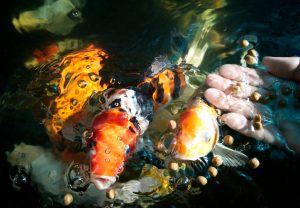
Modern Garden Ponds: Transforming Outdoor Spaces with Elegance
Modern garden ponds have become a popular feature in contemporary gardens, providing both aesthetic appeal and a habitat for wildlife. These ponds can enhance the beauty of a garden while also offering a tranquil retreat. Modern pond design, with its emphasis on still, reflective water and decorative planting, can create a calming atmosphere.
A well-designed modern garden pond can transform any landscape into a serene environment, encouraging relaxation and connection with nature.
Incorporating elements such as LED lighting, aquatic plants, and carefully selected fish can further elevate the pond’s charm. These features not only improve the visual impact but also create a dynamic ecosystem that attracts diverse wildlife. Creating a low-maintenance pond that thrives alongside the garden’s existing flora is achievable with the right planning and design.
Exploring the possibilities of modern garden ponds reveals numerous options tailored to different styles and spaces. From minimalist designs to more elaborate water features, each pond provides an opportunity for personal expression while supporting environmental sustainability. The appeal of modern garden ponds lies in their ability to foster biodiversity and bring peace to everyday life.
Introduction to Modern Garden Ponds
Modern garden ponds have become a staple in contemporary outdoor spaces, offering a serene and peaceful ambiance that can enhance the aesthetic appeal of any garden. A well-designed garden pond can not only add visual interest but also provide a habitat for wildlife, improve air quality, and create a sense of tranquility. Whether you’re looking to create a small, intimate space or a large, elaborate water feature, modern garden ponds offer endless possibilities for design and functionality.
History and Evolution of Garden Ponds
Garden ponds have a rich history that reflects cultural values and advancements in landscape design. From ancient origins to modern innovations, these water features have evolved alongside gardening practices and various styles of garden design.
Origins of Water Features in Gardens
The earliest gardens featuring water can be traced back to ancient civilisations, such as the Egyptians and Mesopotamians. These societies revered water for its life-giving properties, often incorporating it into religious and aesthetic contexts.
In China, the use of ponds in traditional gardens emerged as early as 3000 BCE. These water features symbolised harmony and balance, designed to mimic natural landscapes. The Japanese adopted similar concepts, creating meditative spaces known as “chaniwa,” which prominently featured water for tranquility.
Throughout the Middle Ages in Europe, monastic gardens included ponds to support daily life, providing fish, irrigation, and aesthetic pleasure. These early designs laid the groundwork for modern garden ponds. Today, the concept of a wildlife pond is essential in garden design, emphasizing varied depths and natural habitat elements to support diverse wildlife.
Modern Garden Ponds: A Brief Timeline
The evolution of garden ponds accelerated during the 18th and 19th centuries with the rise of the landscape garden movement. Influenced by figures like Capability Brown, gardens began to incorporate large, naturalistic water features, integrating them into the surrounding landscape.
In the 20th century, garden ponds became more accessible to homeowners. The introduction of liners and prefabricated kits allowed for easier installation and maintenance. The popularity of koi ponds emerged, reflecting a growing interest in ornamental fish.
By the late 20th century, contemporary designs embraced ecological sustainability. Modern ponds now often include features like natural filtration systems and diverse plant life, promoting biodiversity. This shift has made them not just aesthetic additions but also valuable ecosystems in gardens.
Designing a Modern Garden Pond
Creating a modern garden pond involves understanding design principles, selecting the right location, and considering various pond shapes to ensure it harmonises with the surrounding landscape. These elements work together to create an attractive and functional feature in any garden. Incorporating ornamental grasses can enhance the aesthetic of modern pond settings, contributing to a calm atmosphere while providing natural texture and movement against reflective water features.
Principles of Koi Pond Design
Effective pond design begins with its shape and size. For a modern aesthetic, irregular shapes with soft edges often prove more appealing than traditional geometric ones. Integrating natural materials like stones and pebbles enhances the organic feel.
Water depth is equally important, as it influences fish survival and plant health. Most ponds should be at least 60 cm deep in areas to support aquatic life, with some sections reaching 1.5 meters of deep water to accommodate specific fish like koi and various pond plants.
Selecting appropriate plants is vital. Species such as water lilies, reeds, or lotus can provide both beauty and vital habitat. Careful consideration of their placement within the pond enhances visual interest and promotes ecological balance.
Selecting a Suitable Location
The location of the pond significantly affects its functionality and visual impact. A site with morning sun and afternoon shade is ideal. This condition ensures that the water stays cooler and reduces excessive algae growth.
Drainage is another critical factor. The area must not be prone to flooding; a gradient that directs excess water away can prevent damage. Additionally, proximity to existing trees should be considered, as leaves can create maintenance issues.
Proximity to seating areas can enhance enjoyment, allowing one to appreciate the pond’s tranquility. Ensuring it is visible from key vantage points in the garden can elevate its importance within the overall landscape, making it a central feature of your outdoor living spaces.
Integrating Pond Design with Landscape
A modern garden pond should harmoniously integrate with surrounding features. It should complement existing plants and structures, creating a cohesive look. Incorporating pathways, seating, or sculptures can help tie the pond into the greater environment. Additionally, outdoor lighting can enhance the visual impact of the pond, making it a focal point during evening hours.
Using similar materials in pond construction as in nearby garden elements helps strengthen this connection. For example, if natural stone is a feature elsewhere, it should be used in the pond’s edging or lining.
Creating levels can add depth to the design. Shelving around the pond can provide plant placement areas while simultaneously drawing the eye towards the water. This dimensional approach facilitates a variety of ecosystems, enhancing biodiversity.
Creating a Healthy Aquatic Environment
Creating a healthy aquatic environment is crucial for the well-being of your pond’s ecosystem. A balanced ecosystem requires a combination of proper water quality, filtration, and aquatic life. Regular water testing and maintenance can help prevent algae growth, maintain optimal pH levels, and ensure the health of your aquatic plants and fish.
Water Quality and Filtration
Water quality and filtration are essential components of a healthy aquatic environment. A good filtration system can help remove debris, excess nutrients, and waste products from the water, maintaining optimal water quality. Regular water testing can help identify any imbalances or issues, allowing you to take corrective action to maintain a healthy ecosystem.
Selecting Aquatic Plants and Fish for Your Koi Pond
Selecting the right aquatic plants and fish for your koi pond is crucial for creating a balanced and thriving ecosystem. Aquatic plants such as water lilies, cattails, and hornwort can help maintain water quality, provide shelter and food for fish, and add visual interest to your pond. Koi fish, on the other hand, are a popular choice for garden ponds due to their vibrant colors and gentle nature. However, it’s essential to research and choose fish that are compatible with your pond’s size, depth, and water quality.
Eco-Friendly Pond Design
Eco-friendly pond design is becoming increasingly popular as homeowners seek to create sustainable and environmentally friendly outdoor spaces. Eco-friendly pond design involves using natural and sustainable materials, minimizing water waste, and creating a balanced ecosystem that supports local wildlife. Some eco-friendly pond design ideas include using rainwater harvesting systems, incorporating native plants, and creating a naturalistic pond design that blends seamlessly into the surrounding landscape.
By incorporating these eco-friendly design principles, you can create a modern garden pond that not only enhances the aesthetic appeal of your outdoor space but also supports the local environment and wildlife.



